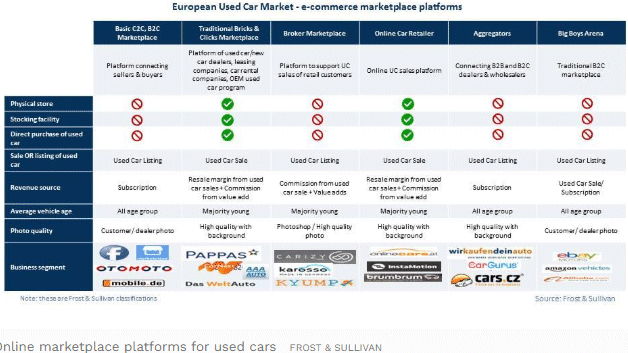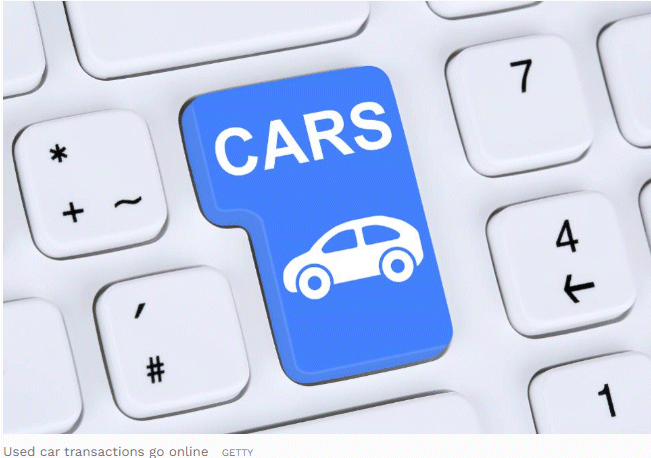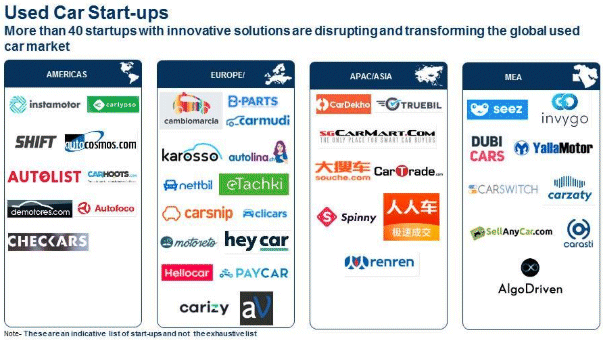The shine may have gone off the new car business but the gloss is still very much on its used car counterpart. Today, used car sales outstrip that of new cars by a margin of almost 2:1 in the U.S., Germany, the U.K, and France. And the key game changer, to my thinking, has been the introduction of a clutch of new digital retailing models that have brought a zing to the used car space. They have essentially reinvented how used cars are bought and sold (no more used car salesman jokes!), while making every element in the process simple, convenient, quick and transparent.
Reinventing How Used Cars Are Bought And Sold
Based on broad similarities—whether B2B, CRC or B2C—and their revenue streams, I believe these new business models can be grouped into six distinct segments.

The first is, of course, the basic C2C/B2C marketplace that serves as a platform connecting sellers and buyers, where both interact directly to complete the transaction. A typical example is the Facebook marketplace, where my friend advertised his BMW X3 before relocating from the U.K. to Australia. He had a few potential buyers contact him within hours of posting the advert and before the end of the week, had an empty garage but a fuller bank account!
On this occasion, the journey, from advertising the sale of the BMW X3 till its actual purchase, was free. However, there are several online used car platforms such as mobil.de in Germany and Otomoto in Poland that generate steady revenues by charging subscription fees either to list or view the used cars for sale.
Then, secondly, there is the traditional brick & clicks marketplaces that are essentially the online sales channel of traditional car dealers, car rental companies, and car leasing companies, which sell both new and used cars.
A good example of this is LeasePlan’s CarNext.com. As an auction house in its original avatar, CarNext targeted professional buyers/the B2B segment. However, in 2018, it launched its retail platform targeting the B2C segment across 24 countries. This platform was positioned as a remarketing channel to sell its used car stocks that were exiting first life leasing.
Similarly, Pappas, a Mercedes Benz dealer in Austria, has leveraged online channels—the Pappas Click & Drive Online Store—to sell both new cars and used car stock. In the UAE, Al-Futtaim Automall offers online buying and selling of used vehicles, with maintenance and repair services thrown into the mix.
The interesting aspect of these marketplaces is their ability to enable a complete online journey from booking to buying a used car. Given the traditional nature of the business, the revenue stream in the bricks & clicks model is through margins generated on the sale of the used car. More recently, this has been reinforced with value added offerings such as financial and insurance services and, in some cases, warranties and logistics support for car deliveries.
What I regard as the third model is the broker marketplace, a digital/online platform involved in selling a used car on behalf of a seller. Think of it as a spruced up, online version of visiting a car dealer, viewing the details of available stocks on car windows, and having an agent handling the end-to-end sale of the car. Here, revenues are created through commissions on the sale of used cars and, sometimes, through value-added services.
Online used car broker CapCar’s stated goal is to enable easy and economical transactions of high quality used cars. It provides support in terms of collating vehicle histories, carrying out detailed vehicle inspections, and assisting with vehicle delivery. In the Middle East’s fast-growing used car market, companies like CarSwitch and Seez have been fast off the blocks, while India’s Cars24 offers an extensive database of used and new cars for purchase and sale, for buyers, sellers and dealers.
The fourth model is that of online car retailers, whom I always think of as the online siblings of traditional bricks & clicks models, albeit with a vital difference. The point of divergence stems from their origin and primary focus as being online stores, which may or may not have an accompanying brick infrastructure.
France’s Aramisauto is a regular multi-brand, online sales platform for used cars that derives its edge from the service it provides of reconditioning used vehicles before reselling them. Italy’s Brumbrum does something along similar lines. Its retail platform allows people to buy used cars and rent new ones. Like Aramisauto, it also buys used cars, services them, and then resells them on its platform. In the Middle East, seller platforms—SellAnyCar.com, SellerAssist, CashAssist of Dubizzle—source cars from private owners and dealers, and then double up as buyer platforms—BuyAnyCar.com and Dubizzle Pro—to facilitate the purchase of used cars.
The fifth digital retail approach is represented by aggregators, like Carwow, who are just that – online platforms for wholesalers, auction houses or dealers to list their offerings in one place. Well established auction houses like BCA and Manheim notwithstanding, companies like AUTO1.com, part of the AUTO1 Group, are now shaking up the used car space. AUTO1.com claims that its online B2B marketplace for used cars is leveraged by more than 60,000 partner dealers in over 30 European countries who use the platform to buy and sell used cars.
And, finally, there is what I like to call the Big Boys segment which includes companies like eBay EBAY +0.6%, Amazon AMZN +7.9% and Alibaba BABA +3.1%. These heavyweights fit the definition of many other segments but are unique enough to qualify for their own exclusive segment. Their distinctiveness springs from the advantages they possess in terms of exceptional financial depth, consumer reach, geographical spread, and infrastructural strength.
Who Will Succeed?
So which of these six models is likely to succeed? I am bullish about the prospects of all of them simply because each has a need and a niche, and is redefining the customer experience in its own way.
As online used car marketplaces really take off, especially post COVID, I think the key performance indicators for these digital retail models will be very similar to those in the traditionally used car business. However, one vital element of success, which I cannot overemphasize, will be the ability to build trust and create transparency across every step of the customer journey.
Subscription is another idea that I believe, should be strongly considered by market participants. The supply of used cars from leasing companies in Europe is expected to reach 7.4 million vehicles in 2023, up from around 6 million in 2019. Add to this, a major finding from our recent survey about consumer interest in subscription services – 68% of survey respondents from Europe indicated a preference for used car subscription offerings.
These trends are a strong indicator that used car companies really need to be looking beyond just buying and selling, and instead of providing a gamut of attractive financing/usership offerings, including used car leasing and subscription.
COVID and digitalization have created an opportunity for industries everywhere to think big, bold, and different. And the used car business is very much on track to do just that.
Article was originally published on Forbes.com





